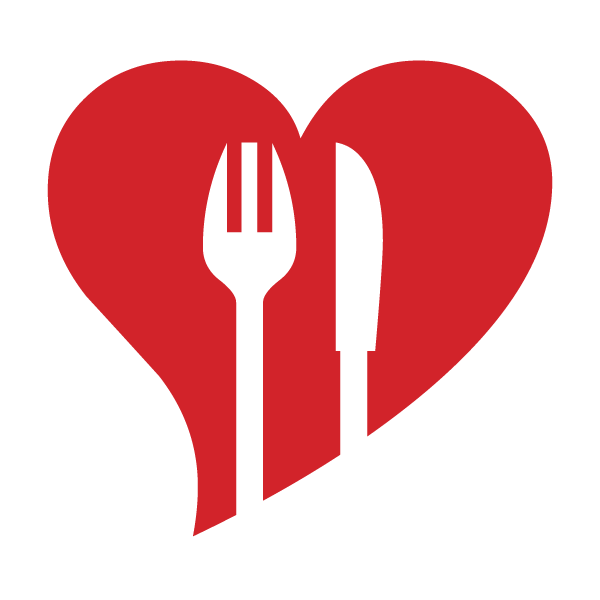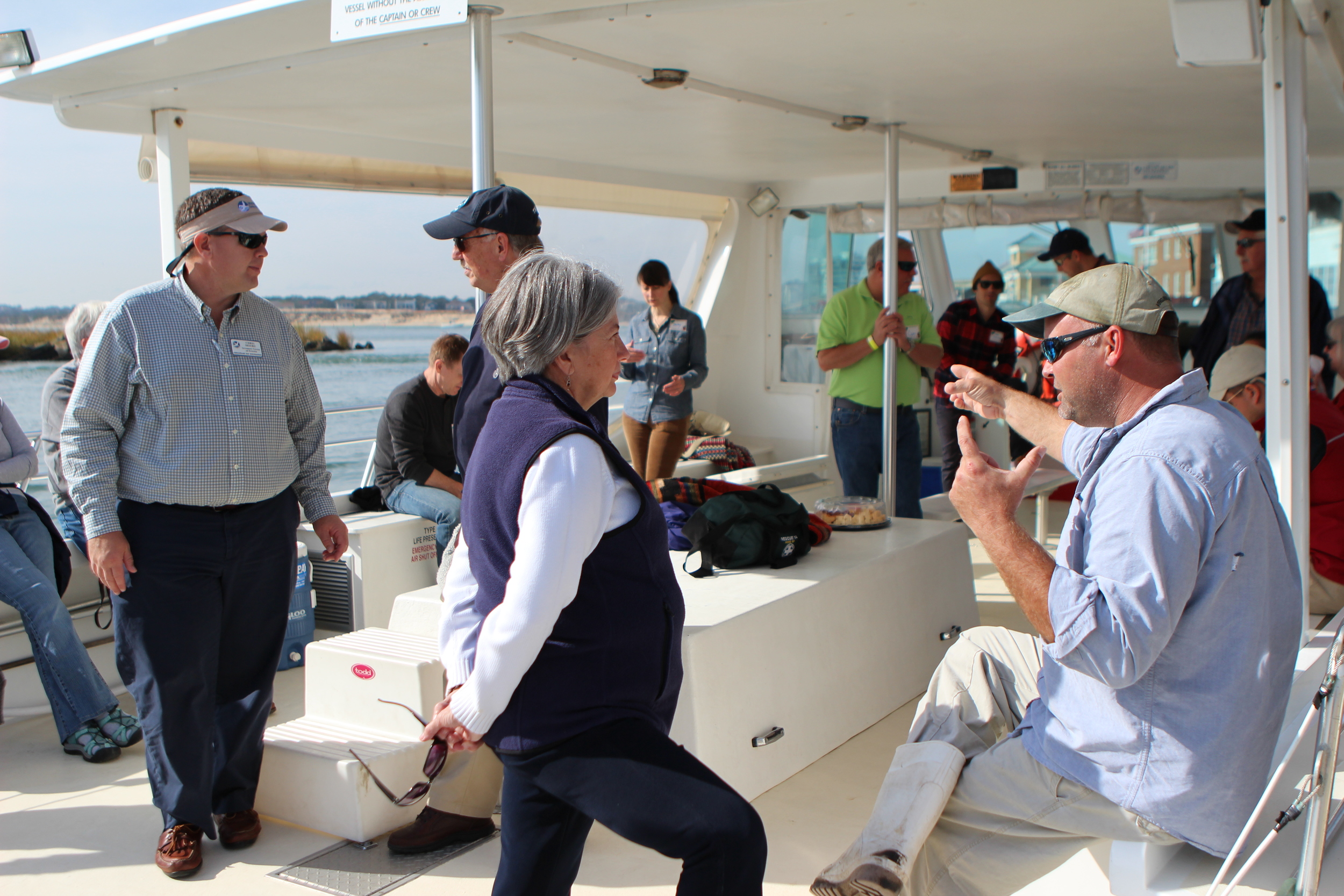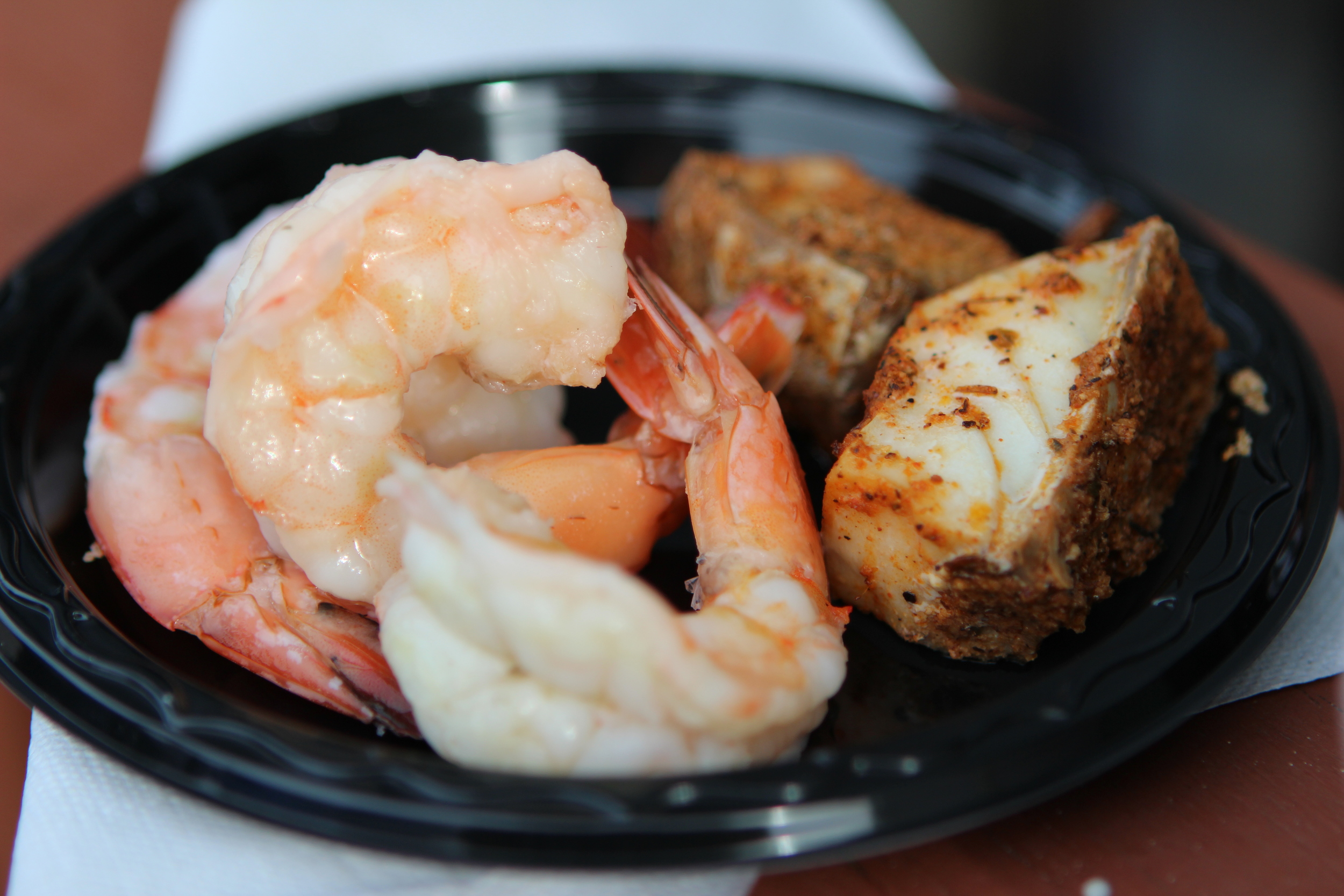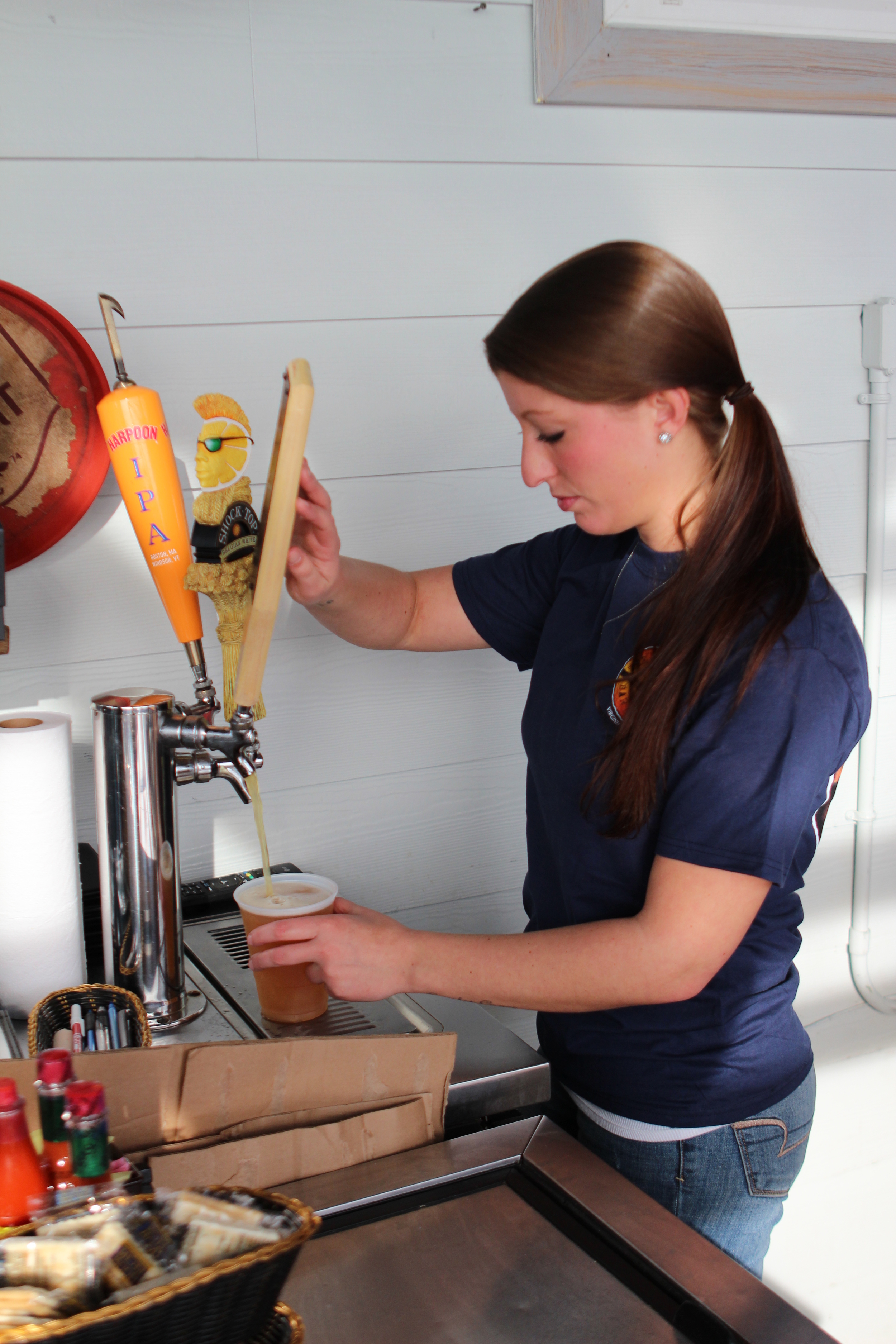Back Bay Brewing released their Lynnhaven River Oyster Stout made with delicious Pleasure House Oysters. The man himself, Chris Ludford, was there shucking his locally raised and farmed oysters to go along with the pints.
Lynnhaven Oysters, big, juicy and holding all the characteristics of the water they were raised in.
Chris Ludford on the Lynnhaven River
When the first Europeans arrived on the shores of the Chesapeake they had an unfortunate skirmish with a group of Native Americans in which both sides retreated a little worse for wear in the end. The Chesapeake natives were on the beach again the next day and when they saw the Europeans heading to shore again they took off to the woods. As the landing party checked out the Indian camp they found large oysters roasting in the fire. Here is a first hand account of settlers getting a taste of the local delicacy recounted in "The Beach: A History of Virginia Beach, Virginia. Virginia Beach Public Library":
"On the second day, another party went ashore and penetrated about eight miles inland without encountering any indigenous settlements. This landing was probably east of Lynnhaven Bay (called
Morton's Bay after their wounded comrade), as the Chesapeakes' principal town was located near the mouth of the Lynnhaven River. Although no Indians were found, the Englishmen did find a fire where
oysters were being roasted. The natives had fled, or at least withdrawn, leaving the oysters in the fire. According to Captain Percy, "We ate some of the oysters which were very large and delicate in
taste." These oysters became known as Lynnhaven oysters and enjoyed an international reputation as delicacies into the twentieth century."
Chris Ludford has been running these waters for decades now and has seen big changes, good and bad, concerning the Lynnhaven. He's active in the preservation of our legacy stock and will take you out on his boat for a first hand experience in oyster farming. Here are his own words on how all of us can help.
"For the last 20 years the Lynnhaven River has either been closed or severely restricted to harvest due to water quality mainly but also due to lack of harvest effort. Fortunately both factors have improved and the latter mainly focused on highly sustainable aquaculture. Recently, however, there has been an increase in the harvest of wild Lynnhaven oysters. This is occurring on privately held bottom and cannot be regulated. We hope that wild harvesters only take a small percentage of their holdings and invest in future wild harvest by planting shell and or seed. An aquafarmer by definition must plant seed or invest in the production of oysters in some way. The unfortunate reality is that removing this stock without respect is akin to clear cutting old-growth forests and is not sustainable. Most of these animals are large, 5+ year-old, spawning stock oysters that we need to rebuild the wild population of the river. Oyster biology is such that the seed of oysters free-floats for a short time over great distances before settling. We desperately need this stock to continue to rebuild the river's wild population and keep her clean with their great powers of filtration."
Check out this link to see how efficiently oysters filter water, courtesy of Lynnhaven River Now
"What will we do? Conservation groups and oystermen on the Lynnhaven are working together to develop a certification or label of sustainability for Lynnhaven River oyster producers. The criteria for this label is being developed and will include a required majority percentage of harvest to be from aquaculture, a limited harvest of wild annually and possibly some work with conservation groups on the river.
What can you do? At this point in time I encourage you all to ask the people, restaurateurs, watermen and dealers that serve/sell wild Lynnhavens to inform you about their origins and methods of harvest. Ask to see the tag. There must be a tag on every bag or box as required by law. Please tell them how valuable wild Lynnhavens are and that it is important to you that they are harvested sustainability and with respect. These animals are literally dinosaurs and the subject of attention from scientists, conservationists and the watermen for their ability to resist disease.
Who is currently doing it right? Quite simply: If a person or business has no aquaculture or farm-raised oysters in their production of Lynnhaven River oysters it would be difficult for themselves to be called a sustainable producer or farmer. If you are buying Lynnhaven oysters you should request farm-raised, sustainable oysters. If you buy wild ask if the producer is limiting their harvest in some way or using spat-on-shell methods to replenish wild stocks harvested.
I want to thank you for taking the time to read this and hopefully act on my recommendations if you find yourself in agreement. Please remember how valuable those large, wild oysters are to river filtration and repopulation.
Thanks!
Chris Ludford"
Merroir Terroir at Terrapin - Jan 2015
This past January's Merroir Terroir at Terrapin was a good one. Local oysterman Chris Ludford and Terrapin's sommelier Daniel Kieser were at the helm of the event with a nice line-up of West Coast oysters and bonus appearance of a local favorite.
Lisa peeking over Rex for a shot.
We arrived just in time to sit and catch the beginning of the event. We were lucky enough to be sandwiched in-between friends and aquintances—Rex and Lisa Hamaker to our left and the Jo Ann and Buzzy Hoffheimer to our right. Chris talked a bit about oysters and some techniques in enjoying the experience. Looking at the oyster being served, the color of the shell can give you an idea of the environment it was raised in, the size and shape are good indicators of what region they came from, etc..
Mr. Chris Ludford
When it came to tasting you want to smell the oyster, sip it's liquor and then slurp it in. You can pick up the different textures of the oyster when you chew it. Some parts are strong then others, some sweeter. He also talked a little bit about umami. Umami has been classified as one of the five basic tastes together with sweet, sour, bitter and salty. It was founded in Japan, hence the name, and was only officially recognized in the 1980s. It is savory and can be found naturally in tomatoes, aged cheese and dry cured hams among other things. Oysters are packed with it!
As we listened to Chris the plates of oysters started to appear from the kitchen. We didn't know what we were going to be having, so it was a pleasant surprise to see what was going to be our launching point.
The first oyster we were having was one of our favorites, the Kusshi. These are from the West Coast and have small, deep bowls. The oysters form these types of shells due to tumbling that breaks off the edges. This prompts the oyster to grow a deeper and thicker shell. Blonde, lavender to dark hues color the scalloped shells. The batch we had were very varied from one to the next. Chris suggested that they might have mixed up several batches from the farming area which caused the differences. Variation in color is due to bottom sediment make-up. Daniel poured a 2012 Domaine Pichot Vouvray Le Peu de la Moriette Demi-Sec from Loire, France with this oyster. The pairing was perfect! Sipping a little bit of the white with a little bit of the oyster in my mouth blended well and highly complimented the flavors of both. Great finish and lingering aftertaste was very pleasant.
Kusshis!
Color variation in Kusshi shells
Terrapin's Sommelier Daniel Kieser
Second, we were poured Sokol Blosser Evolution 18th Edition, a white blend from Oregon. On our plates were the Rolls Royce of oysters – the Kumamoto! These were raised in Humboldt Bay, CA and had salt up front with a sweet, butterly flesh. The bite was crisp and fruity—think green grapes or light melon. I've only had these a couple of times so this was a treat. They are small but pack a punch, I could imagine eating a bag of these by myself. The wine was bright and paired well with the initial saltiness of the oyster liquor; I think the Evolution would definitely be good with spicy food.
Our third course was another variety of Kusshi known as a Shigoku (which means something along the lines of “outstanding” in Japanese), this particular oyster is being marketed under the name “Fat Bastard.” What separates these from other Kusshi oysters is that they are tumbled by the tides themselves. The oysters are put in bags that are suspended by floats so they never touch the bottom. Twice a day when the tides change the oysters are tumbled. I expected the shells to be bright without coloration, but they were lined with thick, dark stripes. Regardless of what the shell looked like (which was pretty!) they oysters were delicious! Shelby said it was her favorite oyster of the night. Meaty with a strong melon finish. We had a 2012 Côte Bonneville Cabernet Franc Rosé from the DuBrul Vinyard in the Yakima Valley, the arid desert region of Central Washington hold ideal growing conditions for certain grapes. It was citrusy, a little strong for the oyster I thought; still a good bottle though.
Fat Bastards
Similar coloring as the Kusshi
We actually got a fourth course and we made our way back to the East Coast with Chris' own Pleasure House Oysters! Salty liquor, juicy, these were bred especially for Terrapin restaurant. Smaller and easier to eat, these were started in 2013. The standard Pleasure House Oyster is huge, the idea behind farming these a little smaller was that it would be a lot less oyster to handle from one shell. The big ones are called chokers for a reason. Daniel poured a 2012 Bollini Pinot Grigio from Trentino, Italy. It went well with the five Lynnhaven mollusks Chris generously gave us. It was my lucky night too, one of the patrons at the end of the bar had a pea crab in her oyster I got to eat. About eating it herself, she said something along the lines of "maybe next time."
Daniel pouring the Bollini Pinot Grigio
Little pea crab
While we enjoyed out oysters and wine Chris described some of the recent conditions of the Lynnhaven. In 2013, Lynnhaven Inlet didn't have as much rain which in turn increased the salinity of the water. These conditions directly affect the flavor of an oyster. The tide has a huge influence on how an oyster tastes too. Tide creates flow, the flow of the water provides food for the oysters. Like most of what we eat, the animal's diet can be detected in its flesh. He said we should consider the oyster when we purchase animals to eat. Try to know where they came from and how they've been handled. The Pleasure House Oysters we ate that night were only touched 15 times before we ate them.
Oh, another nice thing about Merroir Terroir that night is that it was Shelby's Birthday. They brought out a little Valhrona Cocoa Chocolate Pudding with Sea Salt and Olive Oil. Next to the pudding was a single candle that glowed warmly at the low-lit bar. A great way to cap off the evening of great oysters, wine and company.
Hope Shelby's wish comes true
I'm On A Boat!
First, I would like to thank Rex Sr., Lisa and Rex Jr. Hamaker of Taste Tidewater Tours for inviting me to the event. We had a great time!
Buy Fresh Buy Local Hampton Roads (BFBL) in conjunction with Chesapeake Bay Foundation (CBF) and Lynnhaven River Now (LRN) hosted an oyster habitat tour through Lynnhaven Inlet. There were two boat runs, one in the morning and another in the afternoon, taking approximately 50 passengers around Broad Bay Island. Between boat trips there was a reception where we were given information about the history of Lynnhaven oysters, the science behind increasing the population, and how oysters help our waterways.
The Back Deck was our rendezvous point for our group; we lucked out with beautiful weather, sunny and warm. We check in with Rachel Burns from BFBL who gave us our wristbands and drink tickets. At the pier we saw our ride and most of the patrons already on the boat. We jumped on and said our hellos and recognized some faces. I was happy to see Cappy Sinclair on board, also with BFBL, who was getting the wine uncorked and ready to pour once we were underway. We were introduced to Karen Forget of LRN, we also met Chris Moore and Kate Wilson of CBF; they would guide us on our tour.
Our ship’s captain—Jimmy Sollner—took the helm of the Bea Hayman Clark and talked to us a little bit about the boat, safety procedures and how we are all responsible for clean water and what grows in it. Ready and secure we left the pier, Karen began to point out a few things in the inlet. The first small island we passed (Fish Island I believe) was stacked with old concrete from the first Lesner bridge tore down in the 1950s. She showed us oyster castles that are used to help them cluster and grow. Along the bulkheads that protected people’s yards along the channel you could see little oysters glistening in the sun. Some people who have property on the water volunteer to help grow oysters with cages submerged just a few feet from their backyard.
The boat trip around Broad Bay
We made our way down the north side of Broad Bay and passed by First Landing State Park—formerly Seashore State Park if you haven’t been here in a while. We saw several other spots where preservation efforts have taken place. Seeing the park from the water, people walking/jogging along the trails was very interesting. We made our way to the southern side of Broad Bay and headed back to our point of departure.
Back on land the event reception was ready and the next group to go out on the boat were there waiting for us to return. We were served rockfish bites, a buttery clam chowder, huge shrimp, and oysters. More information was given about the Chesapeake Bay and the tributaries that flow to it. CBF, LNR, and BFBL gave examples of the effort they go through to increase the health of the oyster population, and the Bay in general, for everyone to enjoy.
Chris Ludford from Pleasure House Oysters was on deck with some help from Cam Chalmers of Lynnhaven Oyster Company shucking oysters. Chris had a little talk with us about the oysters and showed off some monsters he pulled out of the water just hours earlier. These are the same oysters we had the pleasure of eating—so good, a little salty and meaty. There was a line for these things while the reception was in play. I also need to mention that they had great local beers on tap and Virginian wine available. I had a couple pints of Young Veterans Brewing Co.'s award winning Pineapple Grenade Hefeweizen.
We mingled for a bit and started to make our way home when group two stepped on board the Bea Hayman Clark. It was a great day with good people and food. The day was a great learning experience chased with delicious food and drinks.
Please check out the photos of the inlet and the rest of the trip here.



















